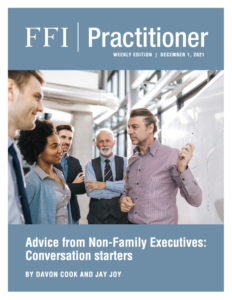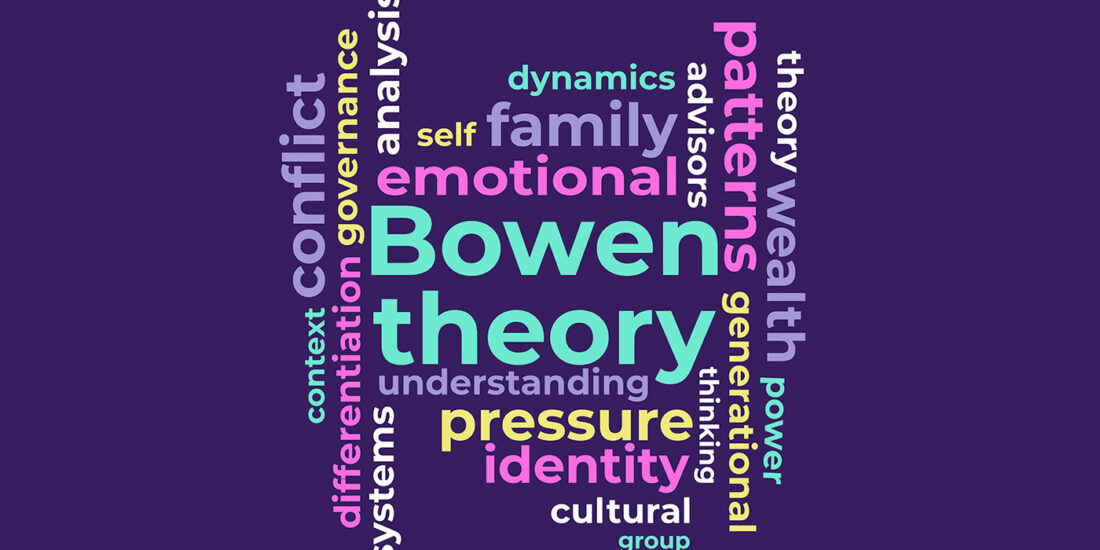
View this edition in our enhanced digital edition format with supporting visual insight and information.
Non-family executives play an important role in a family enterprise – they bring valuable external professional experience to the business and have a unique vantage point of the enterprising family’s dynamics. Thank you to, Davon Cook and Jay Joy, for this week’s edition, which features advice for family business owners from non-family executives. Their comments can make great conversation starters with your clients!
Family business research and best practices often emphasize the value of hiring the right person for the job—family or non-family. Consequently, a successful family business often includes key employees that are not family members. However, it can be tricky to attract and retain this talent when mixed with owner management.
In our consulting practices with small and medium family enterprises, we have helped clients through the hiring, onboarding, and management of strategic non-family executives. They may be the first CFO, COO, or CEO that is not an owner or trusted family member. These individuals can be catalysts for evolution of the business, but as advisors, we sometimes see the company culture and the family culture struggling with how to integrate new ideas and new energy. To gain more insight, we asked some key non-family employees what they wished the owning family could understand and appreciate about their perspective. Their responses, as you can see, were insightful.
Non-Family Executives’ Advice to Family Business Owners
- It is not a sign of weakness or failure to engage non-family members to help run the business; it is often a sign of wisdom and humility. If the business has grown to exceed the skill level or interest level of the family members, strong leaders can recognize the opportunity to evolve.
- It is important for a company to clearly articulate its motivations for hiring non-family strategic employees to team members. When a company decides to hire strategic employees, it often implies that the organization has, or is transitioning to, a culture that includes more team decision-making not just top-down decisions made by the founder, well-defined processes, proactive communication to keep team members informed, and unbiased human resource management.
- It should be an earned privilege, not a birthright, to be employed in the family business. Genetics do not necessarily equal aptitude. Championships in the game of life and business are won by putting the best team on the field—regardless of the names on the back of jerseys.
- All employees should be held to the same standard of performance and accountability, regardless of last name or lineage. Double standards can be a serious threat to an organization’s stability and longevity. Over time, double standards will destroy the morale, motivation, and performance of your highest value teammates.
- Next-generation family members should avoid an immediate return to the family business after they complete education or vocational training. An immediate return does not teach the next generation the valuable skills needed to successfully run an organization, nor does it give them that feeling of self-confidence that they’ve earned their place in the organization on merit as opposed to familial ties.
- Next-generation members are often better prepared to run the business at its full potential and carry it into the future if they purchase at least some portion of the business and, as owners, are allowed to face difficulties and take risks. The strength, wisdom, and resolve that’s needed to successfully lead an organization is forged in the fire of difficulty, struggle, and failure.
- The business family should strive to put aside family issues while at work, at least as much as possible.
- For the sake of children and grandchildren, do not make the business the family’s only identity. Invest time and energy in pursuits beyond the business.
- Remember that non-family employees are also invested in the success of the business. Don’t think the founders and the founders’ family have a monopoly on caring about the company and its people.
- Talent is a lot like capital: it seeks a return. Non-family executives want to feel that they’re building something and also participating in building the company’s legacy. Talented, capable, and committed employees often want to see in the organization’s long-term plan an opportunity to earn their way into the ultimate return—ownership. The quickest way to get employees to think like an owner is to make them one.
This list can be used by practitioners to open conversation on hot topics with their clients. Businesses willing to hear feedback can ask their own non-family executives to react and build upon it. The concepts are those practitioners confront regularly, but hearing from the viewpoints of executives within the system, in addition to advisors, can be powerful.
About the Contributors

Davon Cook, ACFBA, is a Principal at K Coe Isom, providing management consulting, facilitation, and family business advisory services specialized to the food and agribusiness industry. She helps clients navigate through succession planning, strategic management initiatives, estate planning, governance structure, and dispute mediation. Her team facilitates 10 peer executive education groups of family business owners. Davon can be reached at davon.cook@kcoe.com.

Jay Joy has spent his career focused on the business of agriculture. Jay is the founder of Milk Money, LLC., a financial and management coaching practice focused exclusively on helping farmers make more profit. Prior to starting Milk Money, Jay spent nearly 10 years in banking with several leading financial institutions where he financed and advised a number of large commercial dairies, cattle feeders, and grain companies. Jay can be reached at jay@milkmoneycfo.com.

View this edition in our enhanced digital edition format with supporting visual insight and information.





